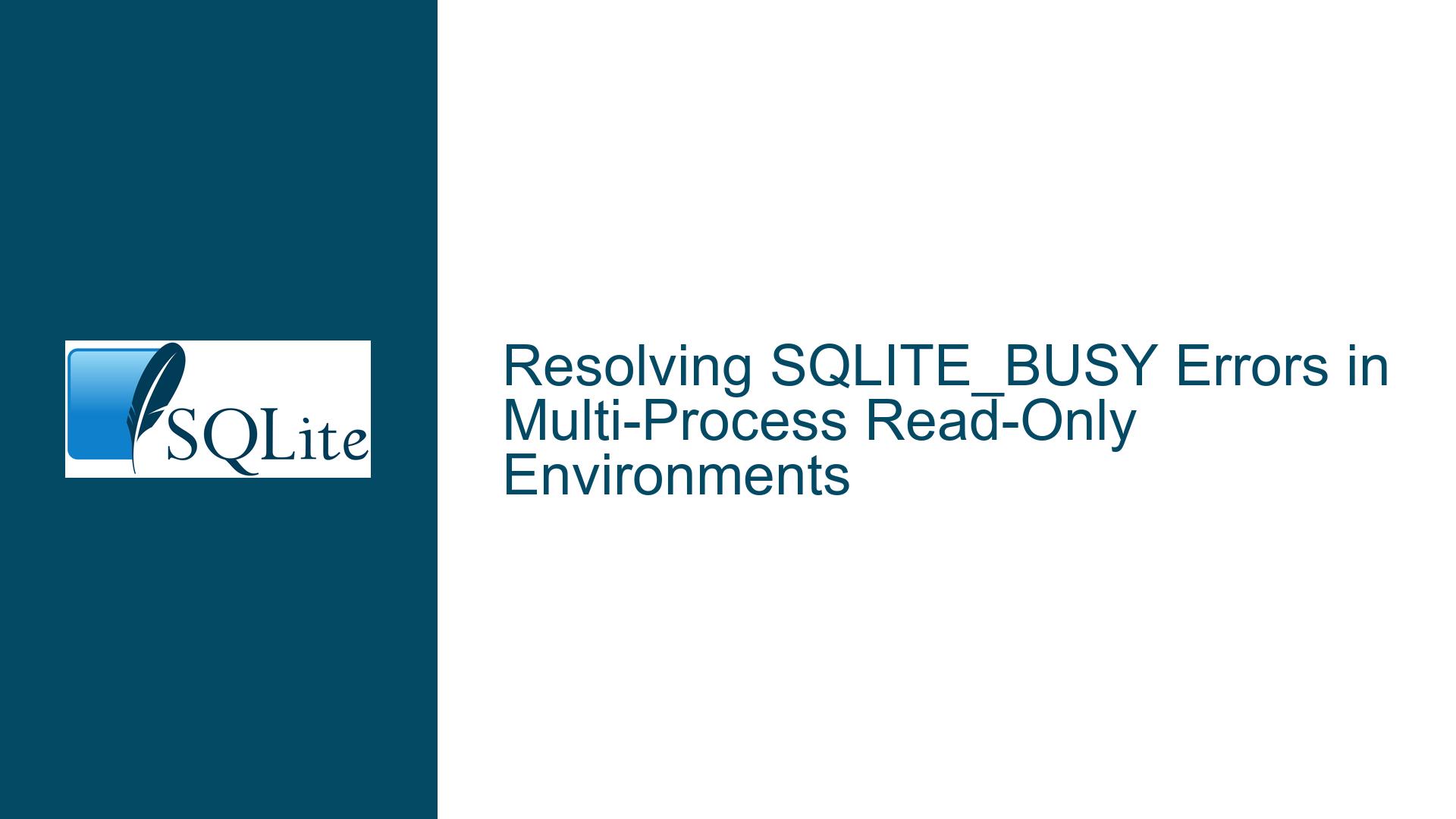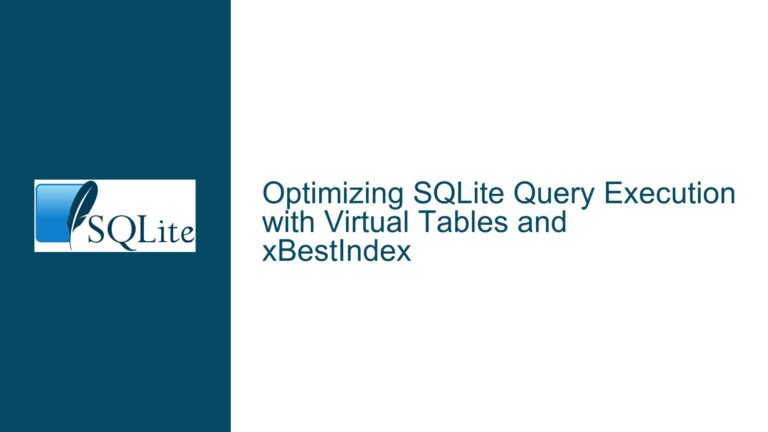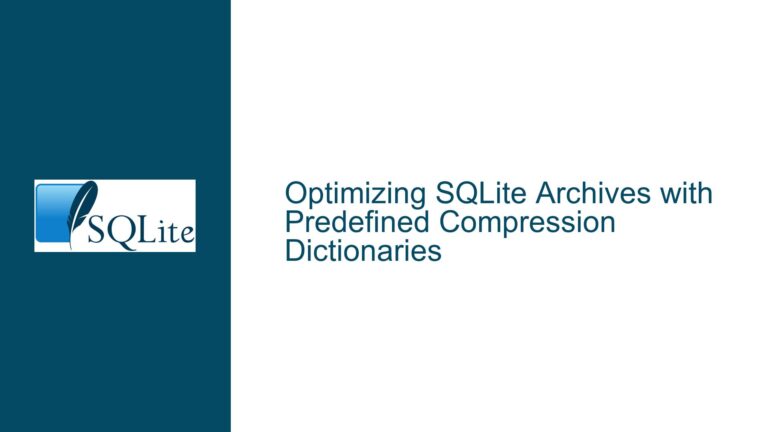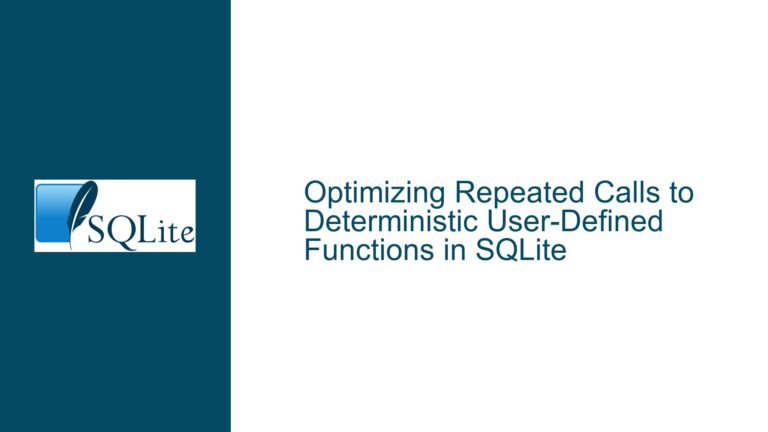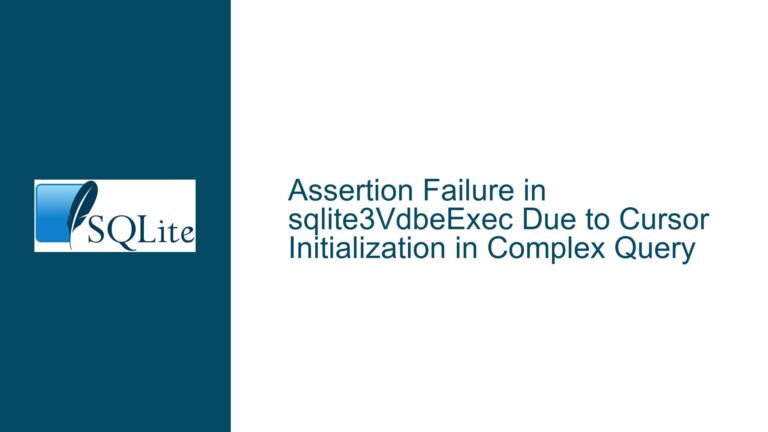Resolving SQLITE_BUSY Errors in Multi-Process Read-Only Environments
Understanding SQLITE_BUSY in Read-Only Multi-Process Workloads
The SQLITE_BUSY error occurs when a database connection attempts to access a resource that is locked by another connection. In read-only workloads, this is unexpected because read operations typically acquire shared locks that allow concurrent access. However, when multiple processes and threads interact with a database using non-default configurations, edge cases can arise. This guide dissects the root causes of SQLITE_BUSY in read-only setups, explores why they manifest, and provides actionable solutions to resolve them.
Diagnosing Lock Contention in Read-Only Configurations
1. Locking Mode and Read-Only Connections
SQLite’s locking mode determines how connections interact with the database file. The locking_mode=EXCLUSIVE pragma instructs a connection to hold an exclusive lock for the duration of its transaction. However, exclusive locks are incompatible with read-only connections. When a read-only connection attempts to set locking_mode=EXCLUSIVE, it cannot acquire the required lock, leading to immediate or deferred conflicts. If multiple processes use this configuration, each connection will repeatedly attempt (and fail) to escalate locks, resulting in sporadic SQLITE_BUSY errors.
2. Transactions and Temporary Tables
Creating temporary tables within a transaction introduces hidden complexity. While temporary tables reside in memory (when temp_store=MEMORY), their creation modifies the temp schema, which is treated as a separate database. Transactions involving the temp schema require locks on the temp database, but the main database may still be involved in lock coordination. If a transaction is left open unintentionally (e.g., not committed or rolled back), the connection retains locks, blocking other operations even in read-only scenarios.
3. Shared Connections and Thread Serialization
Using a single shared connection across multiple threads (with SQLITE_OPEN_FULLMUTEX) serializes operations via an internal mutex. While this ensures thread safety, it introduces bottlenecks if threads perform long-running queries. If the mutex is held for extended periods, other threads in the same process may appear to "block," but this does not directly cause SQLITE_BUSY. Instead, contention arises between connections in different processes, where locks are managed at the filesystem level.
Addressing Configuration and Locking Conflicts
Step 1: Validate Locking Mode Compatibility
Problem: locking_mode=EXCLUSIVE is incompatible with read-only connections.
Solution:
- Remove
PRAGMA locking_mode=EXCLUSIVEfrom the connection configuration. - Use the default
locking_mode=NORMAL, which allows shared locks for reads and escalates locks only when necessary. - Verify the change with
PRAGMA locking_mode;to confirm it is set toNORMAL.
Why This Works:
Read-only connections under NORMAL locking mode acquire shared locks, enabling concurrent access. Escalation to exclusive locks is avoided, eliminating lock conflicts between processes.
Step 2: Audit Transaction Boundaries
Problem: Open transactions during temporary table creation retain locks.
Solution:
- Ensure transactions are explicitly closed after creating temporary tables:
sqlite3_exec(db, "BEGIN; CREATE TEMP TABLE ...; COMMIT;", ...); - Avoid wrapping read-only operations in transactions unless necessary.
Why This Works:
Closing transactions releases locks immediately, preventing lingering locks from blocking other connections.
Step 3: Configure Busy Timeouts
Problem: Transient lock conflicts due to filesystem latency.
Solution:
- Set a busy timeout to allow retries before returning SQLITE_BUSY:
sqlite3_busy_timeout(db, 5000); // Wait up to 5 seconds - Adjust the timeout based on observed contention levels.
Why This Works:
The timeout allows connections to wait for locks to resolve automatically, mitigating transient issues caused by OS scheduling or I/O delays.
Step 4: Isolate Temporary Schema Operations
Problem: Temporary table creation inadvertently affecting main database locks.
Solution:
- Use
PRAGMA temp_store=MEMORYto ensure temporary tables reside purely in RAM. - Confirm no writes occur to the main database with:
PRAGMA schema.journal_mode = OFF; // For main database (if applicable)
Why This Works:
Isolating temporary objects to memory eliminates file I/O and lock coordination for the main database.
Step 5: Verify Read-Only Configuration
Problem: Undetected writes to the main database.
Solution:
- Open the database with
SQLITE_OPEN_READONLYand disable write capabilities:sqlite3_open_v2("file:db?mode=ro", &db, SQLITE_OPEN_READONLY | ..., nullptr); - Monitor the database file’s modification timestamp to rule out accidental writes.
Why This Works:
Enforcing read-only at the API level prevents schema or data modifications that could trigger locks.
Advanced Debugging and System-Level Tuning
1. Logging and Trace Analysis
Enable SQLite’s internal logging to capture lock states and SQL commands:
sqlite3_config(SQLITE_CONFIG_LOG, logCallback, "logfile.txt");
Review logs to identify:
- Transactions left open.
- Unexpected
RESERVEDorEXCLUSIVElock attempts. - Contention points between processes.
2. Filesystem Tuning
SQLite relies on filesystem locks, which vary in performance across OSes.
- Windows: Use a network drive with strict locking semantics.
- Linux: Mount the database directory on a filesystem with robust
fcntl()support (e.g., ext4, not NFS).
3. Connection Pooling
Reduce per-process connections by pooling:
- Assign one connection per thread (instead of per process).
- Use
SQLITE_OPEN_NOMUTEXfor single-threaded connections to reduce overhead.
4. Alternative Locking Strategies
For high-concurrency read workloads:
- WAL Mode: Enable Write-Ahead Logging (even for read-only) to allow reads and writes to coexist.
PRAGMA journal_mode=WAL;Note: WAL requires write permissions for the database and its shared memory files (
-wal,-shm).
Conclusion
SQLITE_BUSY errors in read-only environments stem from misconfigured locking modes, unclosed transactions, or filesystem-level contention. By reverting to locking_mode=NORMAL, enforcing strict transaction boundaries, and isolating temporary objects, most conflicts are resolved. For persistent issues, system-level tuning and advanced logging provide deeper insights into lock coordination. Always validate configurations under load to ensure assumptions about read-only behavior align with SQLite’s internal locking mechanics.
